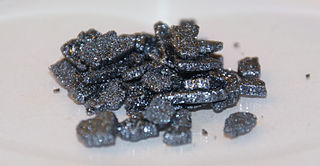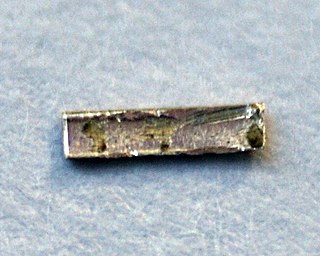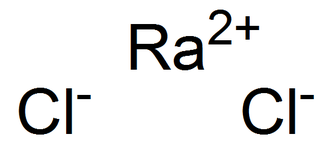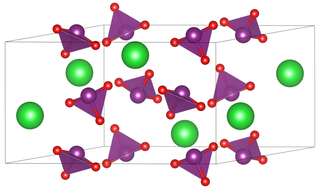
Iodine is a chemical element; it has symbol I and atomic number 53. The heaviest of the stable halogens, it exists at standard conditions as a semi-lustrous, non-metallic solid that melts to form a deep violet liquid at 114 °C (237 °F), and boils to a violet gas at 184 °C (363 °F). The element was discovered by the French chemist Bernard Courtois in 1811 and was named two years later by Joseph Louis Gay-Lussac, after the Ancient Greek Ιώδης, meaning 'violet'.

Radium is a chemical element; it has symbol Ra and atomic number 88. It is the sixth element in group 2 of the periodic table, also known as the alkaline earth metals. Pure radium is silvery-white, but it readily reacts with nitrogen (rather than oxygen) upon exposure to air, forming a black surface layer of radium nitride (Ra3N2). All isotopes of radium are radioactive, the most stable isotope being radium-226 with a half-life of 1,600 years. When radium decays, it emits ionizing radiation as a by-product, which can excite fluorescent chemicals and cause radioluminescence. For this property, it was widely used in self-luminous paints following its discovery. Of the radioactive elements that occur in quantity, radium is considered particularly toxic, and it is carcinogenic due to the radioactivity of both it and its immediate decay product radon as well as its tendency to accumulate in the bones.
In chemistry, the common-ion effect refers to the decrease in solubility of an ionic precipitate by the addition to the solution of a soluble compound with an ion in common with the precipitate. This behaviour is a consequence of Le Chatelier's principle for the equilibrium reaction of the ionic association/dissociation. The effect is commonly seen as an effect on the solubility of salts and other weak electrolytes. Adding an additional amount of one of the ions of the salt generally leads to increased precipitation of the salt, which reduces the concentration of both ions of the salt until the solubility equilibrium is reached. The effect is based on the fact that both the original salt and the other added chemical have one ion in common with each other.

Radium chloride is an inorganic compound with the chemical formula RaCl2. It is a radium salt of hydrogen chloride. It was the first radium compound isolated in a pure state. Marie Curie and André-Louis Debierne used it in their original separation of radium from barium. The first preparation of radium metal was by the electrolysis of a solution of this salt using a mercury cathode.

An iodate is the polyatomic anion with the formula IO−3. It is the most common form of iodine in nature, as it comprises the major iodine-containing ores. Iodate salts are often colorless. They are the salts of iodic acid.

Periodate is an anion composed of iodine and oxygen. It is one of a number of oxyanions of iodine and is the highest in the series, with iodine existing in oxidation state +7. Unlike other perhalogenates, such as perchlorate, it can exist in two forms: metaperiodateIO−
4 and orthoperiodateIO5−
6. In this regard it is comparable to the tellurate ion from the adjacent group. It can combine with a number of counter ions to form periodates, which may also be regarded as the salts of periodic acid.

Sodium iodate (NaIO3) is the sodium salt of iodic acid. Sodium iodate is an oxidizing agent. It has several uses.
Calcium iodate is any of two inorganic compounds with the formula Ca(IO3)2(H2O)x, where x = 0 or 1. Both are colourless salts that occur as the minerals lautarite and bruggenite, respectively. A third mineral form of calcium iodate is dietzeite, a salt containing chromate with the formula Ca2(IO3)2CrO4. These minerals are the most common compounds containing iodate.
Lead(II) iodate is an inorganic compound with the molecular formula Pb(IO3)2. It is naturally found as heavy white powder.

Lithium iodate (LiIO3) is a negative uniaxial crystal for nonlinear, acousto-optical and piezoelectric applications. It has been utilized for 347 nm ruby lasers.

Barium iodate is an inorganic chemical compound with the chemical formula Ba(IO3)2. It is a white, granular substance.
The iodate fluorides are chemical compounds which contain both iodate and fluoride anions (IO3− and F−). In these compounds fluorine is not bound to iodine as it is in fluoroiodates.

Radium sulfate (or radium sulphate) is an inorganic compound with the formula RaSO4 and an average molecular mass of 322.088 g/mol. This white salt is the least soluble of all known sulfate salts. It was formerly used in radiotherapy and smoke detectors, but this has been phased out in favor of less hazardous alternatives.
Radium carbonate is a chemical compound of radium, carbon, and oxygen, having the chemical formula RaCO3. It is the radium salt of carbonic acid. It contains radium cations (Ra2+) and carbonate anions (CO2−3). This salt is a highly radioactive, amorphous, white powder that has potential applications in medicine. It is notable for forming disordered crystals at room temperature and for being approximately 10 times more soluble than the corresponding barium carbonate - witherite. Radium carbonate is one of a few radium compounds which has significantly different properties from corresponding barium compounds. Moreover, radium is the only alkaline-earth metal which forms disordered crystals in its carbonate phase. Even though radium carbonate has very low solubility in water, it is soluble in dilute mineral acids and concentrated ammonium carbonate.
Radium compounds are compounds containing the element radium (Ra). Due to radium's radioactivity, not many compounds have been well characterized. Solid radium compounds are white as radium ions provide no specific coloring, but they gradually turn yellow and then dark over time due to self-radiolysis from radium's alpha decay. Insoluble radium compounds coprecipitate with all barium, most strontium, and most lead compounds.

Iodine dioxide is a binary inorganic compound of iodine and oxygen with the chemical formula IO
2. Only stable as a dilute gas, this compound is one of many iodine oxides, and "iodine dioxide" is sometimes used to describe its formal dimer, the salt diiodine tetroxide (I2O4, [IO]+[IO3]−).
Radium tungstate is an inorganic compound of radium, oxygen, and tungsten with the chemical formula RaWO4. This is a salt of wolframic acid and radium.
Promethium iodate is an inorganic compound with the chemical formula Pm(IO3)3. It can be obtained by reacting with potassium iodate, ammonium iodate or a slight excess of iodic acid and Pm3+ solution and precipitating it. Its hydrate, Pm(IO3)3·H2O, crystallizes in the P21 space group, with unit cell parameters a=10.172±13, b=6.700±20, c=7.289±24 Å, β=113.1±0.2°.
Gadolinium iodate is an inorganic compound with the chemical formula Gd(IO3)3. It is produced by reacting gadolinium metal with periodic acid at 180 °C. Its solubility in water is 0.893±0.002 (25 °C, 103 mol·dm−3). Adding ethanol or methanol to water will reduce the solubility.
Dysprosium iodate is an inorganic compound with the chemical formula Dy(IO3)3. It can be obtained by the reaction of dysprosium nitrate or dysprosium chloride and iodic acid at 200 °C. It exists in two crystal forms: α-form and β-form. Its solubility in water at 25 °C is 1.010±0.001 10−3 mol·dm−3). Adding ethanol or methanol to water will reduce the solubility.










